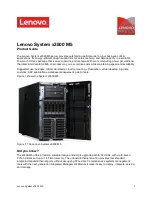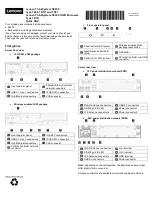
Running the System Diagnostics
5-11
Subtests
The subtests that constitute the System Set Test Group
and the computer functions they confirm follow:
•
CMOS Confidence Test
Checks the NVRAM for accessibility and reliability
of data storage by performing a data pattern check
and verifying the uniqueness of memory addresses.
•
EISA Configuration Memory Test
Verifies the accessibility and reliability of the RAM
on the Extended Industry-Standard Architecture
(EISA) configuration RAM chip, which stores the
EISA hardware configuration information. On sys-
tems without flash RAM, performs a data pattern
and address uniqueness test.
•
DMA Controller Test
Tests the direct memory access (DMA) controller
and verifies the correct operation of its page and
channel registers by writing patterns to the registers.
•
Real-Time Clock Test
Confirms the functionality and accuracy of the com-
puter’s real-time clock (RTC).
•
Timers Test
Checks the timers used by the microprocessor for
event counting, frequency generation, and other
functions. Only the functions that can be activated
by software are tested.
•
Interrupt Controller Test
Generates an interrupt on each interrupt request
(IRQ) line to verify that devices using that line can
communicate with the microprocessor(s) and that the
interrupt controllers send the correct memory
addresses to the microprocessor(s).
•
Speaker Test
Checks the functionality of the speaker by generat-
ing eight tones.
•
x87 Calculation Test
Checks the use of different types of numbers and the
math coprocessor’s ability to calculate correctly.
•
x87 Duty Cycle Test
Tests the math coprocessor’s ability to perform com-
plex mathematical operations.
•
x87 Error Exception Test
Verifies the math coprocessor’s ability to handle
errors and to send IRQs to the microprocessor.
•
Apic Test and Apic MP Test
For systems with multiprocessors, confirms that the
additional microprocessors are operational.
Why Run a System Set Test?
The System Set subtests double-check many system
board components, such as the computer’s input/output
(I/O) circuitry, that are tested by other test groups or
subtests in the diagnostics. You should run the System
Set Test Group if you are having a problem and cannot
isolate the failure or malfunction to a particular system
board component.
The System Set Test Group also verifies the proper oper-
ation of other computer components, such as the speaker,
that are not tested elsewhere in the diagnostics.
The following symptoms usually suggest a problem with
a component or subassembly that warrants running a Sys-
tem Set subtest:
•
A program is not running as usual, or a proven piece
of software appears to malfunction and you confirm
that the software itself is not at fault. You can con-
firm that the software is functioning properly by
moving it to another computer and running it there.
•
An option card you previously accessed can no
longer be accessed.
•
You get parity errors or page fault failures (any error
message that contains the words parity or page fault)
at any time during operation. These errors are usu-
ally accompanied by a reference to an address,
which you should record on a copy of the Diagnos-
tics Checklist found in Appendix A.
•
Correcting errors in the system configuration infor-
mation in the system setup program or the system
configuration utility does not resolve a problem.
•
The computer’s clock/calendar stops.
Summary of Contents for 6100
Page 1: ... HOO 3RZHU GJH 6 VWHP 167 7 21 1 7528 6 227 1 8 ...
Page 8: ...x ...
Page 18: ...xx ...
Page 20: ...xxiv DELL CONFIDENTIAL Preliminary 12 17 96 ...
Page 32: ...3 6 Dell PowerEdge 6100 200 System Installation and Troubleshooting Guide ...
Page 52: ...5 18 Dell PowerEdge 6100 200 System Installation and Troubleshooting Guide ...
Page 78: ...7 22 Dell PowerEdge 6100 200 System Installation and Troubleshooting Guide ...
Page 124: ...11 16 Dell PowerEdge 6100 200 System Installation and Troubleshooting Guide ...
Page 134: ...B 8 Dell PowerEdge 6100 200 System Installation and Troubleshooting Guide ...
















































